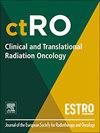肾上腺肿瘤立体定向消融放疗(SABR)后脾体积的变化
IF 2.7
3区 医学
Q3 ONCOLOGY
引用次数: 0
摘要
目的:脾照射可导致危及生命的感染。更新的剂量限制已被推荐给接受放化疗和常规放疗的患者,但在立体定向消融放疗(SABR)的试验中没有指定脾限制。我们研究了肾上腺转移患者接受SABR的脾剂量和脾体积(SV)的晚期变化。材料和方法从伦理批准的数据库中确定采用屏息磁共振引导SABR治疗肾上腺转移的患者。脾剂量限制不常用。在屏气CT和mr扫描上回顾性描绘脾脏。平均脾脏剂量(MSD)和相对V5-10-20-30Gy值由基线计划得出。在6-12-24个月的随访CT扫描上测量SV。采用回归分析评估SV变化与脾剂量和其他参数的关系。结果113例肾上腺肿瘤采用5段(64%)、3段(19%)或单段(14%)给药。51%的患者在SABR期间或前后3个月内接受了全身治疗。左侧肿瘤占总数的56%,基线中位MSD和V10Gy分别为9.7 Gy (1.5-28.4 Gy)和46.3%(0 - 100%)。右侧肾上腺平面相应值分别为1.5 Gy (0.2-5.9 Gy)和0%(0 - 6.2%)。在多变量分析中,较高的MSD与左侧侧度显著相关(p <;0.001)、较高的处方剂量(p = 0.02)和较大的GTV (p <;0.001)。MSD为>;28例(25%)患者观察到10 Gy。其中,46%的患者在6个月时(n = 59), 40%的患者在12个月时(n = 47), 50%的患者在24个月时(n = 31), SV下降超过20%。结论:在MSD为10 Gy的肾上腺SABR患者中,有40 - 50%的患者脾脏体积明显缩小。脾萎缩的临床意义值得进一步研究。本文章由计算机程序翻译,如有差异,请以英文原文为准。
Changes in splenic volumes following stereotactic ablative radiotherapy (SABR) to adrenal tumors
Purpose
Splenic irradiation can result in life-threatening infections. Updated dose constraints have been recommended for patients undergoing chemoradiotherapy and conventional radiotherapy but splenic constraints were not specified in trials of stereotactic ablative radiotherapy (SABR). We studied splenic doses in patients undergoing SABR for adrenal metastases and late changes in splenic volume (SV).
Material and Methods
Patients treated with breath-hold MR-guided SABR for adrenal metastases were identified from an Ethics-approved database. Splenic dose constraints were not routinely used. The spleen was delineated retrospectively on both breath-hold CT and MR-scans. Mean spleen dose (MSD) and relative V5-10-20-30Gy values were derived from the baseline plan. SV was measured on available follow-up CT scans at 6–12–24 months. Regression analyses were performed to assess SV changes in relation to splenic dose and other parameters.
Results
SABR was delivered to 113 adrenal tumors mostly using 5 fractions (64 % of tumors), 3 fractions (19 %) or a single fraction (14 %). Systemic therapy was administered during or within 3 months preceding/after SABR in 51 % of patients. Left-sided tumors comprised 56 % of total, and baseline median MSD and V10Gy were 9.7 Gy (range 1.5–28.4 Gy) and 46.3 % (range 0–100 %), respectively. Corresponding values for right-sided adrenal plans were 1.5 Gy (0.2–5.9 Gy) and 0 % (0–6.2 %), respectively. In multivariable analysis, a higher MSD was significantly associated with left laterality (p < 0.001), higher prescription dose (p = 0.02), and larger GTV (p < 0.001). An MSD of > 10 Gy was observed in 28 patients (25 %). Among these, a greater than 20 % decrease in SV was found in 46 % of patients with available follow-up at 6 months (n = 59), 40 % at 12 months (n = 47) and 50 % at 24 months (n = 31).
Conclusion
Substantial reductions in spleen volume occur in 40–50 % of patients treated with adrenal SABR with an MSD of >10 Gy. The clinical relevance of splenic atrophy merits further study.
求助全文
通过发布文献求助,成功后即可免费获取论文全文。
去求助
来源期刊

Clinical and Translational Radiation Oncology
Medicine-Radiology, Nuclear Medicine and Imaging
CiteScore
5.30
自引率
3.20%
发文量
114
审稿时长
40 days
 求助内容:
求助内容: 应助结果提醒方式:
应助结果提醒方式:


